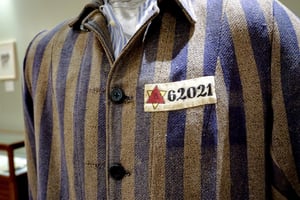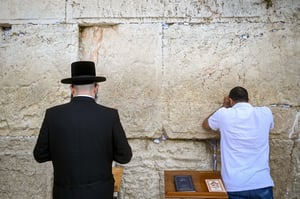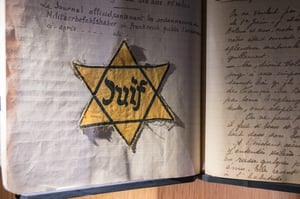
The broader public discussion on the place of women in Orthodox synagogues would only take place decades later, but special siddurim for women were published already in the first half of the twentieth century. The first of these appears to have been produced by the famous Evelina de Rothschild school in Jerusalem in 1910, and was mostly meant for the female students learning there. Like most educational siddurim, this one was also fairly restricted in its contents and design.
A few decades later, in 1945, the Jerusalem-based Eshkol press released a far bigger siddur for women – the Korban Minchah – which included both prayers for all year round and a comprehensive collection of halachas regarding women’s obligations under Judaism. The basis for the siddur, as noted by the inner cover, was as a new edition of the Shirah Chadashah siddur, with the Hebrew commentary by Rabbi Chaim David Rosenstein, to which the press had acquired the rights to print and distribute.
The siddur was also unique in the portions accompanying the payers themselves: the Amirah Lebeit Yaakov halachic collection – which covered questions of niddah, challah, candle lighting, and salting food – as well as the entire Sefer Tehillim, something which was not included in the original Shiah Chadashah. The book’s name, it should be noted, preserved the names of a variety of siddurim published under the same name in Europe from the end of the nineteenth century onward.
Meanwhile, the Amirah Lebeit Yaakov halachic collection was written by rabbi Yitzhak Dov Bamberger, the Rabbi of Wurzburg, Germany. It was first printed in 1858 – in German, but with Hebrew letters (as was common then in religious literature meant for women). Its goal was to fight the winds of secularism and Haskalah which began to threaten many communities throughout Central Europe, and was therefore supported by many of Judaism’s senior, small “c” conservative Rabbis – including Rabbi Shamshon Rafael Hirsch. In the coming decades, the book was published in several editions, and its reprinting in Hebrew in 1945 was initiated by Rabbi Bamberger’s grandson, Rabbi Dr. Simchah Halevi Bamberger, a well-known religious Zionist Rabbi and educator in Bnei Brak, who is commemorated there to this day.
In the introduction to the halachic collection, he now translated into Hebrew and attached to the siddur, Rabbi Bamberger thanked a number of Rabbis who helped him in his work, as well as a number of his colleagues who provided him with the Kuntres Dinei Taharah on halachic laws of purity, which was distributed among the first religious kibbutzim.
Addressing the times in which the siddur was reappearing, Bamberger wrote: “And may be that the renewal of the language and form of ‘Amirah Lebeit Yaakov’ will bring about the renewal of life and deeds, connecting the holiness of the families of Israel to the holiness of the Land of Israel, and bring forth a plenty of purity and holiness to the restoration of our land and the revival of our people.”
With such an approach, it’s no wonder that the new siddur was welcomed and supported with haskamos from some of the senior religious Zionist Rabbis, including Rabbi Benzion Meir Chai Uziel, Rabbi Yaakov Moshe Charlap, and Rabbi Isaac Halevi Herzog, who even added an introduction of his own, at the end of which he said: “Return dear daughters, return to the source of the purity of Israel, return to the laws of our Holy Torah.”
As already mentioned, the siddur also included a complete Sefer Tehillim, divided according to the days of the week and month, something which was also considered part of the classical world of Jewish women’s prayer at the time. However, despite its rich content and high-level production, the siddur was only printed in a few editions, the last of which was in 1973, with Ashkenazic and Sefardic versions for either community.
This may be due to its great heft, and despite the fact that it was considered to be a very common gift for would-be brides in the sixties and seventies. It turns out that most congregants preferred other siddurim – more visually appealing, and perhaps also less halachically imposing.
Dr. Reuven Gafni is a senior lecturer at the Land of Israel Department at Kinneret College. He specializes in the field of synagogues and religion in the Land of Israel in the modern era, and the relationship between Jewish religion, culture, and national identity in the Land of Israel.
















0 Comments